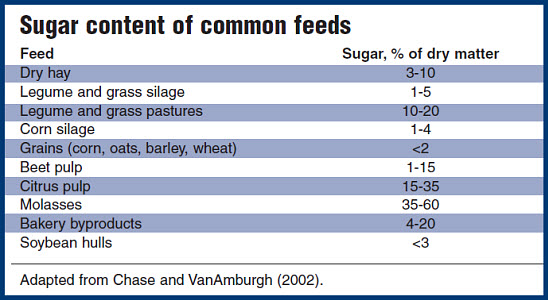Harvest, Storage Factors
As discussed in a previous column (Mahanna, 2009), cutting alfalfa later in the day as a means to increase sugar content has research that falls on both sides of the debate. Although a.m. versus p.m. forages differ in initial sugar composition, it is not clear whether these differences still exist after drying and/or fermentation due to cellular respiration reducing sugar levels at night or in the portion of narrow-swathed windrows not receiving direct sunlight.
Research in Wisconsin (Undersander, 2003) showed that 11 of 14 Wisconsin farm samples had higher sugars with later-cut alfalfa, yet only one of the 14 had higher sugar levels in stored forage.
Miner Institute research (Thomas, 2001; Thomas, 2007) showed no statistical difference in plant sugars, starches, NDF or in vitro digestibility. While later-harvested alfalfa was numerically higher in sugar and starches, the small differences either decreased or disappeared entirely by the time the forage was at 40% dry matter. The alfalfa mowed in the morning was ready for silage harvest in about nine hours, while the alfalfa mowed in the late afternoon was not harvestable until after lunch the following day.
Many researchers in the Midwest and East believe it makes more sense to harvest early in the day to maximize the hours of drying from solar radiation rather than expose the crop to delayed drying or increased weather risk.
Cornell researchers (Kilcer, 2006) investigated the benefit of wide-swathing to reduce drying time and also reduce sugar losses in the field. Their study showed that narrow-swathing (40% of cut width) resulted in an 18% loss in sugars in the fi rst 24 hours of fi eld curing compared to only a 5% loss in sugars when wide-swathing (90% of cut width).
It appears that the wide swath not only allows for more rapid moisture loss, but the exposure of the cells to upwards of three times more sunlight during the drying process allowed for photosynthetic production of sugars even while the crop was field wilting.
Their studies also show an improved lactic acid: acetic acid ratio in fermented wide-swath alfalfa and grass, presumably because more sugars were available to drive the fermentation process.
Silage management plays an important role in conserving sugars. The dry matter loss in silages is primarily sugar or starch. Reducing silage dry matter shrink losses by five percentage points (e.g., from 20% to 15%) is equivalent to adding about 40 lb. of sugar to every wet ton of alfalfa silage. It makes little sense to worry about sugars on the front end of harvest only to have them lost to spoilage, aerobic bacteria or poor silage management.

